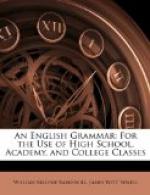5. The world has all its eyes on Cato’s son.
6. My quarrel and the English queen’s are one.
7. Now the bright morning star, day’s harbinger,
Comes dancing
from the East.
8. A man’s nature runs either to herbs or weeds; therefore, let him seasonably water the one, and destroy the other.
9. ’Tis all men’s office to speak
patience
To those that wring
under the load of sorrow.
10. A jest’s prosperity lies in the ear
Of him that hears it,
never in the tongue
Of him that makes it.
11. No more the juice of Egypt’s grape shall moist his lip.
12. There Shakespeare’s self, with every
garland crowned,
Flew to those fairy
climes his fancy sheen.
13. What supports me? dost thou ask?
The conscience, Friend,
to have lost them [his eyes] overplied
In liberty’s defence.
14. Or where Campania’s plain forsaken
lies,
A weary waste expanding
to the skies.
15. Nature herself, it seemed, would raise
A minster to her Maker’s
praise!
HOW TO PARSE NOUNS.
69. Parsing a word is putting together all the facts about its form and its relations to other words in the sentence.
In parsing, some idioms—the double possessive, for example—do not come under regular grammatical rules, and are to be spoken of merely as idioms.
70. Hence, in parsing a noun, we state,—
(1) The class to which it belongs,—common, proper, etc.
(2) Whether a neuter or a gender noun; if the latter, which gender.
(3) Whether singular or plural number.
(4) Its office in the sentence, determining its case.
[Sidenote: The correct method.]
71. In parsing any word, the following method should always be followed: tell the facts about what the word does, then make the grammatical statements as to its class, inflections, and relations.
MODEL FOR PARSING.
“What is bolder than a miller’s neckcloth, which takes a thief by the throat every morning?”
Miller’s is a name applied to every individual of its class, hence it is a common noun; it is the name of a male being, hence it is a gender noun, masculine; it denotes only one person, therefore singular number; it expresses possession or ownership, and limits neckcloth, therefore possessive case.
Neckcloth, like miller’s, is a common class noun; it has no sex, therefore neuter; names one thing, therefore singular number; subject of the verb is understood, and therefore nominative case.
Thief is a common class noun; the connection shows a male is meant, therefore masculine gender; singular number; object of the verb takes, hence objective case.




